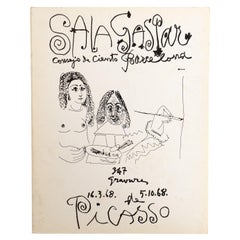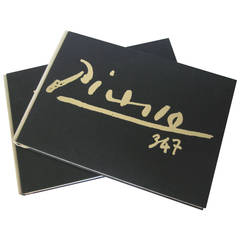Picasso 347 Catalog
Vintage 1960s Spanish Mid-Century Modern Books
Paper
Vintage 1960s Spanish Mid-Century Modern Books
Paper
Recent Sales
Vintage 1960s Swiss Mid-Century Modern Books
People Also Browsed
20th Century Spanish Modern Books
Paper
Vintage 1960s Danish Mid-Century Modern Chairs
Wood
2010s Mexican Post-Modern Side Tables
Onyx
20th Century Italian Posters
Linen, Paper
Vintage 1980s Spanish Mid-Century Modern Books
Paper
Vintage 1940s American Modern Books
Paper
Vintage 1960s German Bauhaus Musical Instruments
Metal, Aluminum
1930s American Modern Landscape Drawings and Watercolors
Graphite
1960s Modern More Prints
Lithograph
20th Century Russian Posters
Paper
Mid-20th Century American Mid-Century Modern Musical Instruments
Chrome
20th Century Italian Mid-Century Modern Cabinets
Brass
Vintage 1940s American Machine Age Books
Paper
20th Century British Post-Modern Posters
Acrylic, Paper
Early 20th Century Russian Art Deco Posters
Paper
Vintage 1970s Russian Posters
Paper
Finding the Right Books for You
Antique and vintage books add a sense of culture and style to any room. Displaying these types of books in your living room or reading nook can warm a space with a distinguished feel.
Several factors make antique books highly desirable. Original jackets, ornate binding, illustrations and quality of the print all contribute to making a vintage book special. Rare books are of great interest to collectors in the know and can command high prices at auction. In 2021, an important early artist book by Andy Warhol sold at auction for more than $106,000. Somewhere between all the commercial work he did as an ambitious young graphic designer in the early 1950s and his first real debut as a Pop artist a decade later, Warhol produced a trove of incredibly charming drawings. His illustrated self-published artist books from the 1950s are very rare.
Many collectors seek the first edition of certain books. Fewer copies of a book and higher demand make it a rare find. A book that contains the author’s signature also makes it much more prized than other examples of the same title.
Collectors and designers decorate rooms with vintage books for a cozy feeling in a home. Coffee-table books, such as those featuring photography and design, serve as conversation pieces or offer a relaxing moment when leafed through.
Interior designers look for vintage books when they want to add color or detail. For instance, leather-bound books can create a scholarly air while mid-century titles offer a modern edge. Vintage international books or first editions can provide a sense of history.
No matter the genre, there is a book for you. You can find rare, one-of-a-kind antique books on 1stDibs. Browse by authors, like celebrated architect and designer Frank Lloyd Wright and Edgar Rice Burroughs, as well as by period, including mid-century modern, Art Deco and Victorian.
Read More
39 Incredible Swimming Pools
It's hard to resist the allure of a beautiful pool. So, go ahead and daydream about whiling away your summer in paradise.
May’s Most Popular Interiors on Instagram
Our feed is filled with the world's most beautiful spaces. See the rooms our followers have deemed the best of the best this month.


